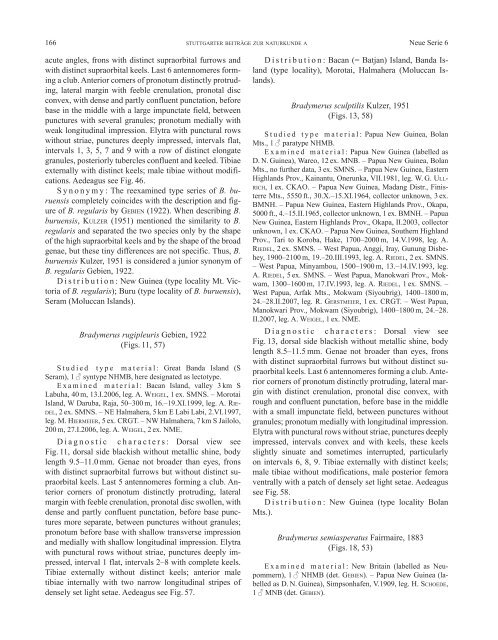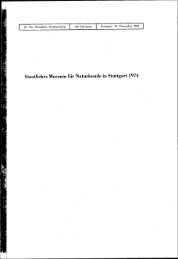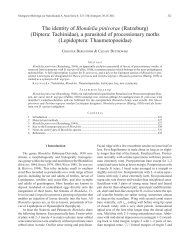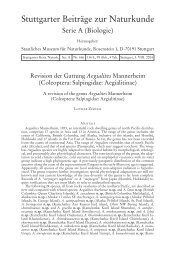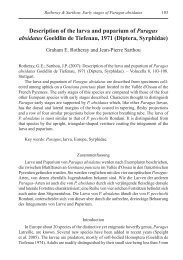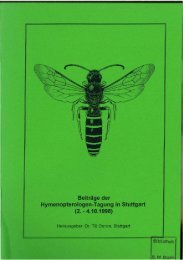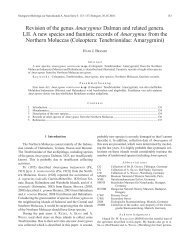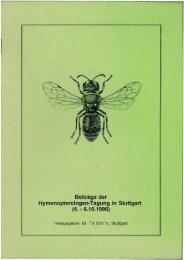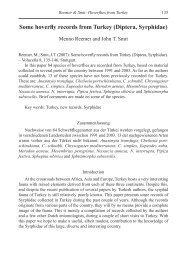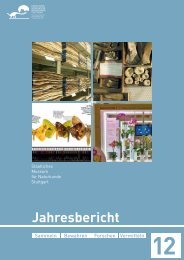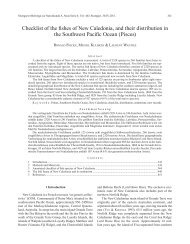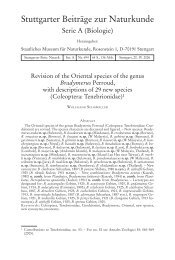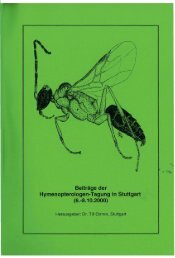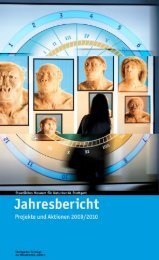The species of Bradymerus Perroud (Coleoptera: Tenebrionidae ...
The species of Bradymerus Perroud (Coleoptera: Tenebrionidae ...
The species of Bradymerus Perroud (Coleoptera: Tenebrionidae ...
Create successful ePaper yourself
Turn your PDF publications into a flip-book with our unique Google optimized e-Paper software.
166 STUTTGARTER BEITRÄGE ZUR NATURKUNDE ANeue Serie 6acute angles, frons with distinct supraorbital furrows andwith distinct supraorbital keels. Last 6 antennomeres forminga club. Anterior corners <strong>of</strong> pronotum distinctly protruding,lateral margin with feeble crenulation, pronotal discconvex, with dense and partly confluent punctation, beforebase in the middle with a large impunctate field, betweenpunctures with several granules; pronotum medially withweak longitudinal impression. Elytra with punctural rowswithout striae, punctures deeply impressed, intervals flat,intervals 1, 3, 5, 7 and 9 with a row <strong>of</strong> distinct elongategranules, posteriorly tubercles confluent and keeled. Tibiaeexternally with distinct keels; male tibiae without modifications.Aedeagus see Fig. 46.Synonymy: <strong>The</strong> reexamined type series <strong>of</strong> B. buruensiscompletely coincides with the description and figure<strong>of</strong> B. regularis by GEBIEN (1922). When describing B.buruensis, KULZER (1951) mentioned the similarity to B.regularis and separated the two <strong>species</strong> only by the shape<strong>of</strong> the high supraorbital keels and by the shape <strong>of</strong> the broadgenae, but these tiny differences are not specific. Thus, B.buruensis Kulzer, 1951 is considered a junior synonym <strong>of</strong>B. regularis Gebien, 1922.Distribution: New Guinea (type locality Mt. Victoria<strong>of</strong> B. regularis); Buru (type locality <strong>of</strong> B. buruensis),Seram (Moluccan Islands).<strong>Bradymerus</strong> rugipleuris Gebien, 1922(Figs. 11, 57)Studied type material: Great Banda Island (SSeram), 1 ♂ syntype NHMB, here designated as lectotype.Examined material: Bacan Island, valley 3 km SLabuha, 40 m, 13.I.2006, leg. A. WEIGEL, 1 ex. SMNS. – MorotaiIsland, W Daruba, Raja, 50–300 m, 16.–19.XI.1999, leg. A. RIE-DEL, 2 ex. SMNS. – NE Halmahera, 5 km E Labi Labi, 2.VI.1997,leg. M. HIERMEIER, 5 ex. CRGT. – NW Halmahera, 7 km S Jailolo,200 m, 27.I.2006, leg. A. WEIGEL, 2 ex. NME.Diagnostic characters: Dorsal view seeFig. 11, dorsal side blackish without metallic shine, bodylength 9.5–11.0 mm. Genae not broader than eyes, fronswith distinct supraorbital furrows but without distinct supraorbitalkeels. Last 5 antennomeres forming a club. Anteriorcorners <strong>of</strong> pronotum distinctly protruding, lateralmargin with feeble crenulation, pronotal disc swollen, withdense and partly confluent punctation, before base puncturesmore separate, between punctures without granules;pronotum before base with shallow transverse impressionand medially with shallow longitudinal impression. Elytrawith punctural rows without striae, punctures deeply impressed,interval 1 flat, intervals 2–8 with complete keels.Tibiae externally without distinct keels; anterior maletibiae internally with two narrow longitudinal stripes <strong>of</strong>densely set light setae. Aedeagus see Fig. 57.Distribution: Bacan (= Batjan) Island, Banda Island(type locality), Morotai, Halmahera (Moluccan Islands).<strong>Bradymerus</strong> sculptilis Kulzer, 1951(Figs. 13, 58)Studied type material: Papua New Guinea, BolanMts., 1 ♂ paratype NHMB.Examined material: Papua New Guinea (labelled asD. N. Guinea), Wareo, 12 ex. MNB. – Papua New Guinea, BolanMts., no further data, 3 ex. SMNS. – Papua New Guinea, EasternHighlands Prov., Kainantu, Onerunka, VII.1981, leg. W. G. ULL-RICH, 1 ex. CKAO. – Papua New Guinea, Madang Distr., FinisterreMts., 5550 ft., 30.X.–15.XI.1964, collector unknown, 3 ex.BMNH. – Papua New Guinea, Eastern Highlands Prov., Okapa,5000 ft., 4.–15.II.1965, collector unknown, 1 ex. BMNH. – PapuaNew Guinea, Eastern Highlands Prov., Okapa, II.2003, collectorunknown, 1 ex. CKAO. – Papua New Guinea, Southern HighlandProv., Tari to Koroba, Hake, 1700–2000 m, 14.V.1998, leg. A.RIEDEL, 2 ex. SMNS. – West Papua, Anggi, Iray, Gunung Disbehey,1900–2100 m, 19.–20.III.1993, leg. A. RIEDEL, 2 ex. SMNS.– West Papua, Minyambou, 1500–1900 m, 13.–14.IV.1993, leg.A. RIEDEL, 5 ex. SMNS. – West Papua, Manokwari Prov., Mokwam,1300–1600 m, 17.IV.1993, leg. A. RIEDEL, 1 ex. SMNS. –West Papua, Arfak Mts., Mokwam (Siyoubrig), 1400–1800 m,24.–28.II.2007, leg. R. GERSTMEIER, 1 ex. CRGT. – West Papua,Manokwari Prov., Mokwam (Siyoubrig), 1400–1800 m, 24.–28.II.2007, leg. A. WEIGEL, 1 ex. NME.Diagnostic characters: Dorsal view seeFig. 13, dorsal side blackish without metallic shine, bodylength 8.5–11.5 mm. Genae not broader than eyes, fronswith distinct supraorbital furrows but without distinct supraorbitalkeels. Last 6 antennomeres forming a club. Anteriorcorners <strong>of</strong> pronotum distinctly protruding, lateral marginwith distinct crenulation, pronotal disc convex, withrough and confluent punctation, before base in the middlewith a small impunctate field, between punctures withoutgranules; pronotum medially with longitudinal impression.Elytra with punctural rows without striae, punctures deeplyimpressed, intervals convex and with keels, these keelsslightly sinuate and sometimes interrupted, particularlyon intervals 6, 8, 9. Tibiae externally with distinct keels;male tibiae without modifications, male posterior femoraventrally with a patch <strong>of</strong> densely set light setae. Aedeagussee Fig. 58.Distribution: New Guinea (type locality BolanMts.).<strong>Bradymerus</strong> semiasperatus Fairmaire, 1883(Figs. 18, 53)Examined material: New Britain (labelled as Neupommern),1 ♂ NHMB (det. GEBIEN). – Papua New Guinea (labelledas D. N. Guinea), Simpsonhafen, V.1909, leg. H. SCHOEDE,1 ♂ MNB (det. GEBIEN).


